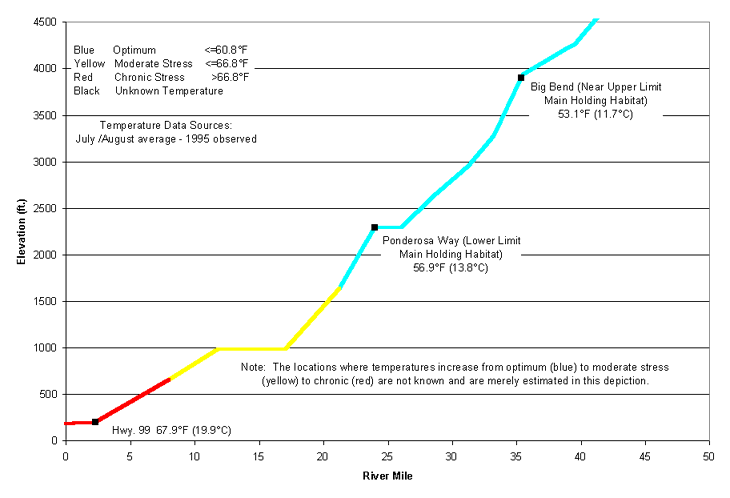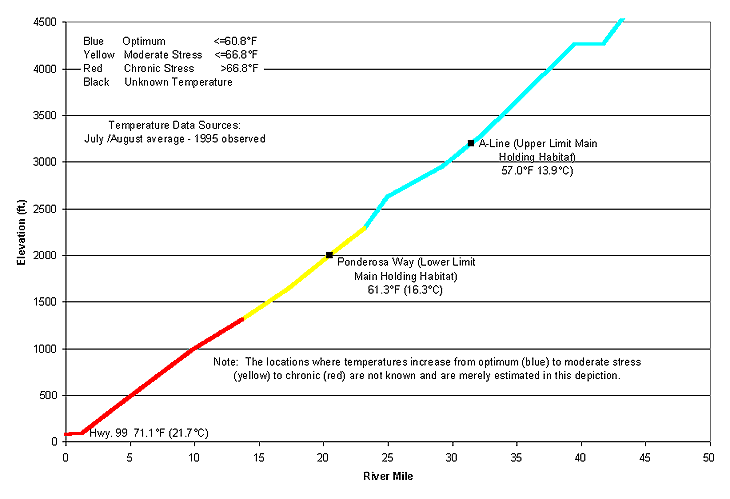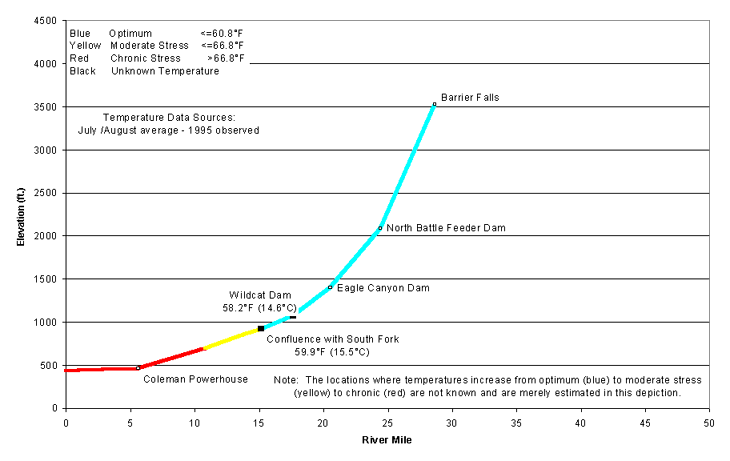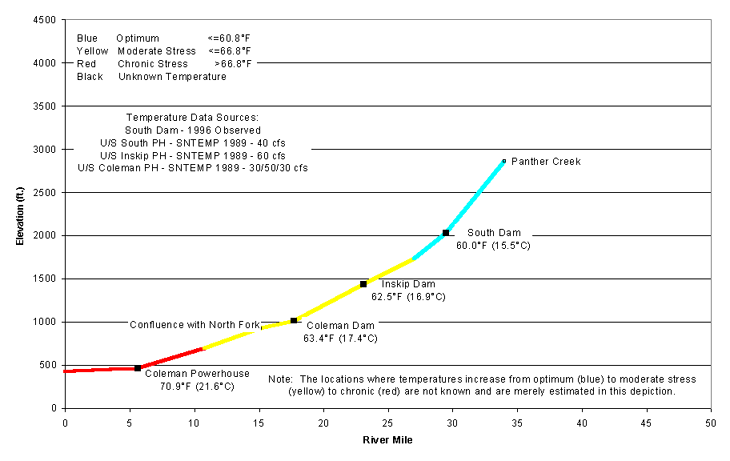

 |
 |
|
Spring Chinook Distribution
by Elevation
![]()
The first two charts on this page show the range of spring chinook, elevation and water temperature in Deer Creek and Mill Creek. These Sacramento River tributaries, which are adjacent to Battle Creek, have fewer impediments to migration. The next two charts show the elevation and temperature of North Fork and South Fork Battle Creek and demonstrate that considerable suitable spring chinook habitat exists in both forks if flows are sufficient.
All temperatures were measured in 1995 except for the South Fork Battle Creek where temperature data was based on a composite of 1996 data and 1989 data taken during times of high flow releases by Thomas R. Payne and Associates.
Temperatures in Deer Creek and Mill Creek are suitable for spring chinook only above 2000 and 2400 feet in elevation, respectively. The North Fork Battle Creek would have excellent habitat for spring chinook even in the lowest reaches at less than 1000 feet elevation because cold springs feed the creek. The South Fork also has spring influences and would maintain at least acceptable habitat in its lower reaches under a restored flow regime. The Battle Creek charts also indicate that the mainstem might provide some acceptable habitat for spring chinook holding in wet years.
The charts show average water temperatures in August and July. The colors indicate suitability for spring chinook.
| Avg. T<=60.8 F (good habitat) | |
| Avg. T =60.8 - 66.2 (acceptable habitat) | |
| Avg. T >66.2 (poor habitat) |
| Mill Creek | N.F. Battle Creek |
| Deer Creek | S.F. Battle Creek |
Mill Creek
Mill Creek spring chinook hold between 2400 and 4000 feet in elevation. 1995
water temperatures were optimal in the entire holding reach (53.1 F to
56.9 F). Figure 5 in the Restoration Plan shows conditions in Mill Creek in
1992, when water flows were considerably lower and temperatures in the holding
reach were higher (58.3 F to 62 F).

Graph from Battle Creek Salmon and Steelhead Restoration Plan (Kier Associates
1998)
Deer Creek
Deer Creek spring chinook hold in reaches that range from 2000 to 3200 feet
in elevation. Average water temperature was excellent for spring chinook holding
in the upper reaches of (57 F) in 1995 but only acceptable in lower reaches
(61.3 F). In 1992, all the holding habitat in Deer Creek was between 60.8 F
and 66.5 F (Figure 3 in Restoration Plan). Higher water temperatures were related
to low flows in 1992.

Graph from Battle Creek Salmon and Steelhead Restoration Plan (Kier Associates
1998)
North Fork Battle Creek
The North Fork Battle Creek maintained optimal temperatures for spring chinook
holding down to its convergence with the South Fork (<59.9 F). Flows in 1995
were similar to those projected under restoration because more than 30 cfs was
being released for flows in the North Fork. High flows help maintain cool temperatures.

Graph from Battle Creek Salmon and Steelhead Restoration Plan (Kier Associates
1998)
South Fork Battle Creek
South Fork Battle Creek water temperatures shown in this graph are from several
water years, but all with flows in the range of projected restored conditions.
Temperatures are projected to be optimal to below South Dam (60 F) and acceptable
for spring chinook holding below Coleman Dam (63.4 F). It appears that water temperatures
in the South Fork would be suitable for spring chinook at elevations below 1000
feet.

Graph from Battle Creek Salmon and Steelhead Restoration Plan (Kier Associates 1998)
![]() References
References
Armour, C. L. 1991. Guidance for evaluating and recommending temperature regime to protect fish. Biological Report 90(22). US Fish and Wildlife Service. Ft. Collins, CO. 13 pp. [316kb]**